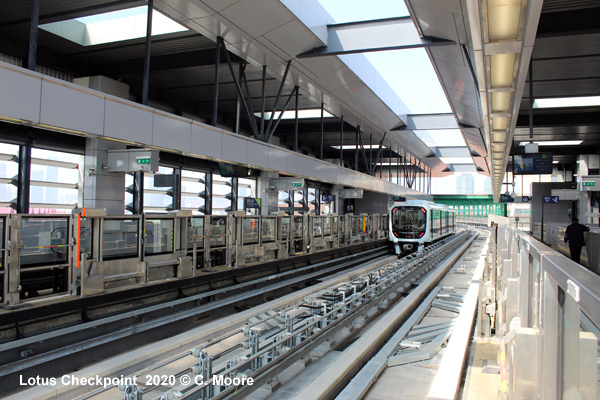
|
[ UrbanRail.Net ] [ Europe ] [ Americas ] [ Asia ] [ Africa ] [ Oceania ] [ News ] [ Books ] [ Links ] |
|
MACAU
|
| China |

|
MACAU
|
|
Like Hong Kong, Macau (or Macao) is a Special Administrative Region in China, located 65 km west of Hong Kong across the Pearl Delta, and 100 km south of Guangzhou; 650,000 inhabitants - driverless rubber-tyred light metro system under construction: Stage 1: Portas do Cerco - Barra - Terminal Maritimo da Taipa (20 km, 21 stations) Rolling
stock supplied by Mitsubishi Heavy Industries, with the "Ocean Cruiser"
similar to the latest rolling stock operating on Tokyo's Yurikamome Line.
|
|
History
|
|
10 Dec 2019: Linha da Taipa Oceano - Terminal Marítimo da Taipa (9.3 km) 20
Oct 2021: service suspended for approx. 6 months due to repair work
|
|
Photos
|










|
|
Links
|
|
Macau Metro at Wikipedia
|
|
Report
|
|
In Jan. 2020, Craig Moore reports from Macau: Macau Getting there. Whilst Macau does not have the intercontinental links of Hong Kong, there is a well-developed set of options for arrival, including flights from regional and Chinese cities, ferries to Hong Kong, Shenzhen and Zhuhai, buses to Hong Kong and nearby Chinese cities via the amazing Hong Kong-Zhuhai-Macau Bridge, or most interestingly, the land crossing at Gongbei in Zhuhai. Known as ‘Barrier Gate’ (0700-2400), the facility is located next to Zhuhai Railway Station (for trains across China). It abounds with activity through the day as masses of scurrying locals/travellers are directed down numerous barriered queues to the PRC immigration hall. Most people use the E-gates (for PRC/Macau citizens) but there are also many traditional immigration barriers. The ‘Foreigners’ queue is reasonably quiet and after passing through a tatty, broad corridor with money changers etc, you arrive at the Macau immigration barriers which has many ‘Visitante’ posts. Despite the huge volumes of people using the Gongei barrier, the facility has been well designed to handle the flow through and it is a joy to experience. From entry to exit was 15mins but allow for 35mins at busy periods. On leaving the immigration building in Macau you are instantly reminded of the past glories of the Lusophone world with the remnants of the 19th century ‘Porta da Fronteira’. Here also is a bus station for services across Macau (a walk to the UNESCO area is 30mins from here). Buses from this station or the main bus station at Hotel Lisboa (near UNESCO area) take passengers across the sea bridge to Taipa (flat fare 6 Pataca-€0.65). Macau LRT Escalators from the street (with totem), and elevated walkways across the road, provide access to the mezzanine. These shady, cool areas have open sides for ventilation and house ticket/info office, information board with vicinity map and line map, and ticket machines (6-10 Pataca/€0.65-1.10) which dispense blue tokens for use on the modern, stylish ticket gates. Smart signage directs passengers to stairs/escalators for the side platforms (lifts also). The platforms are built for four car trains and have basic furnishings with RTI screens, a tiny (pointless) traditional clock, station name signage, seating and metallic half barriers which includes a vertical strip map. Most stations have a dark grey arched roof with central gap, but there a few exceptions - Taipa Ferry Terminal and Lotus Checkpoint have square roofs; Airport has a pleasing red design with broad side panels; and at Ocean Station, the platform is in island form and lies below the elevated mezzanine as the line here is at grade following a decline from Jockey Club. This is a fully automated, driverless rubber-tyred system and uses Mitsubishi Crystal Mover APM stock, branded as ‘Ocean Cruiser’. The trains come in the form of two individual carriages rather than a through train and each carriage has two very broad doors on each side. The exterior is in a very pale blue with broad black side band, a large front widow and angled red lighting. The interior is bright, clean and spacious, with basic, quite unattractive dynamic strip map and smart line map in sticker form. There is metallic side seating and plentiful grab bars and handles. These are very much required as the acceleration profile of the train is erratic. This is a speedy system which breaks very suddenly at stations and bends, the track is quite bumpy and this, together with the meandering nature of the route mean it is quite an uneven and uncomfortable ride. That said, this is an easy system to use. Wayfinding is excellent and the branding has been well executed. The dark blue/green colour scheme is elegant, and there is plentiful information available at all stations, which are staffed by a legion of friendly personnel. Signage across the system is in three languages (Chinese/Portuguese/English) and audio also has the additional Cantonese as spoken in Macau. Macau LRT has also taken the decision to identify every station with a modern icon which adds nicely to the brand. The locals seem very proud of their new light rail system and most of the few passengers at the moment are pleasure riders. Perhaps when the system is fully extended to Macau city there will be greater demand. |
2016 © Robert Schwandl (UrbanRail.Net)